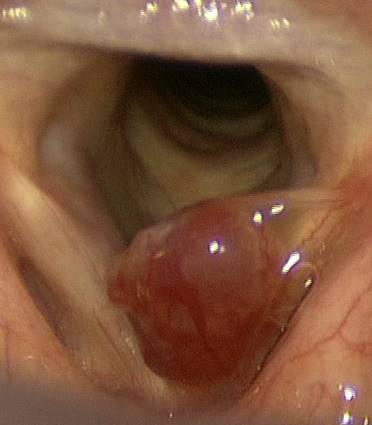
For dysphonia is the difficulty in producing the entry, There are different types of dysphonia (hoarseness, sclerofonia, Aphonia). In some subjects may have problems only in singing (disodia).
The problem may be constant or fluctuating or may occur only after a longer or shorter by use of voice (astenofonia, fatigue or vowel).
Dysphonia is not a disease but a symptom that can have multiple causes:
–dysfunctional: due to an incorrect use of the item (malmenage) and/or intense voice use (overwork) without organic diseases. May be accompanied by "break" vowels, cough, scraping.
–dysfunctional for organic evolution: in some individuals a dysfunctional dysphonia can over time cause of lesions of vocal cords as (nodules, polyps) that can accentuate the dysphonia and trigger a vicious cycle.
–benign organic: inflammation, Reinke's edema, laryngomalacia, subglottic stenosis, laryngeal aperture, synechiae, sottoglottici hemangiomas, chord cysts, sulcus sulcus glottidis, Papillomatosis.
–malignant organic: carcinomas, sarcomas.
–from hormonal changes: underactive thyroid, hyperthyroidism (rarely), pregnancy.
–neurological disease: Parkinson, myasthenia gravis, SLA.
–from paralysis/paresis recurrential
–psychogenic: typical of the falsetto voice of speech outline.
Most forms of dysphonia persisted over time are dysfunctional, often associated with a professional use of voice (teachers, singers, call center employees, speakers), more frequent in women and often occur even in Kids.
A use prolonged or incorrect use of the item and breathing works abnormally vocal cords, they tend to touch each other more strongly and more frequently, the muscles get tired and the sound produced is not optimal.
This type of dysphonias are correctable with the reduction in the use of the voice and learning breathing techniques and forming (often with the help of a speech therapist).
If the dysfunctional dysphonias persist over time or if there are vocal efforts very important (es a crying baby) the "accidents" can be such as to create on the vocal cords are called nodules, small "callosities" or small haemorrhages that may justify the formation of vocal cord polyps. These lesions accentuate the dysphonia and one can thus create a vicious. While it is difficult to spontaneous resolution of an Octopus folds you can the regression and the disappearance of vocal cord nodules fixing the voice Setup.
The gastroesophageal reflux is another major irritant that can cause dysphonia in the context of a reflux laringopatia.
Even the smoking and alcohol ’ can cause dysphonia, the speech is more complex. Both can act as an irritant and over time can cause precancerous or malignant lesions of vocal cords. Obviously the situation is more delicate and more complex management. Cigarette smoke can cause inflammation that ’ edemizzare (inflate) the vocal cords: Reinke's edema.
When the dysphonia lasts for over 15 days it is important to carry out a visit with ORL exam fibroscopico. This lets you see in a non-invasive way his vocal cords and, especially, exclude the presence of benign or malignant lesions.
As we have already said, as for the dysfunctional dysphonias and vocal nodules therapy is to reduce the vocal abuse, correct errors by setting the voice and breathing with the help of a speech therapist.
With regard to the pharmacological therapy is reflux laringopatia.
Benign glottiche lesions (persistent lumps after speech therapy, the polyps, the cysts, the solcus, granulomas.) the therapy is surgical with direct intervention in microlaringoscopia in suspension under general anesthesia.

Precancerous lesions must be removed with the similar technique, with the help of the CO2 LASER.
Malignant tumors can see a more complex with a number of different surgical treatments (LASER cordectomie, Subtotal laringectomie, total laryngectomy) and radio-chemotherapy, that depend on the tumor extension ’.









